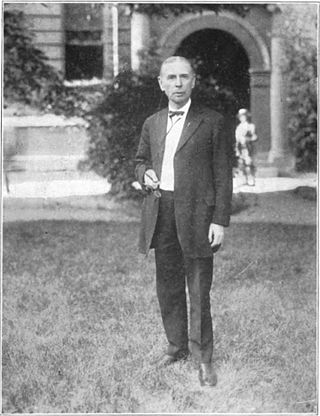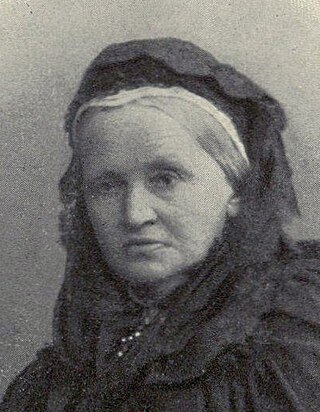
The Lutheran Church – Missouri Synod (LCMS), also known as the Missouri Synod, is a confessional Lutheran denomination in the United States. With 1.7 million members as of 2022 it is the second-largest Lutheran body in the United States, behind the Evangelical Lutheran Church in America. The LCMS was organized in 1847 at a meeting in Chicago, as the German Evangelical Lutheran Synod of Missouri, Ohio, and Other States, a name which partially reflected the geographic locations of the founding congregations.
Pietism, also known as Pietistic Lutheranism, is a movement within Lutheranism that combines its emphasis on biblical doctrine with an emphasis on individual piety and living a holy Christian life.

Martin Stephan (1777–1846) was pastor of St. John Lutheran Church in Dresden, Germany during the early 19th century. He organized the Saxon emigration to the United States in the early 19th century.

The Evangelical Lutheran Synodical Conference of North America, often known simply as the Synodical Conference, was an association of Lutheran synods that professed a complete adherence to the Lutheran Confessions and doctrinal unity with each other. Founded in 1872, its membership fluctuated as various synods joined and left it. Due to doctrinal disagreements with the Lutheran Church–Missouri Synod (LCMS), the Evangelical Lutheran Synod (ELS) and the Wisconsin Evangelical Lutheran Synod (WELS) left the conference in 1963. It was dissolved in 1967 and the other remaining member, the Synod of Evangelical Lutheran Churches, merged into the LCMS in 1971.

John Kilian also German: Johann Kilian, Upper Sorbian: Jan Kilian, pronounced[ˈjaŋˈkʲilʲi.an] was a Lutheran pastor and leader of the colony known as the Wends of Texas.

Samuel Simon Schmucker was a German-American Lutheran pastor and theologian. He was integral to the founding of the Lutheran church body known as the General Synod, as well as the oldest continuously operating Lutheran seminary and college in North America.

Franz August Otto Pieper was a Confessional Lutheran theologian who also served as the fourth president of the Lutheran Church – Missouri Synod, known at that time as the German Evangelical Lutheran Synod of Missouri, Ohio, and Other States.

Johann Gottfried Scheibel was a German theologian and a leader of the Old Lutherans.
Old Lutherans were German Lutherans in the Kingdom of Prussia, especially in the Province of Silesia, who refused to join the Prussian Union of churches in the 1830s and 1840s. Prussia's king, Frederick William III, was determined to unify the Protestant churches, homogenize their liturgy, organization, and architecture. In a series of proclamations over several years the Church of the Prussian Union was formed, bringing together a group that was majority Lutheran and minority Reformed. As a result, the government of Prussia had full control over church affairs, with the king recognized as the leading bishop.
The name Agenda is given, particularly in the Lutheran Church, to the official books dealing with the forms and ceremonies of divine service.
Gnesio-Lutherans is a modern name for a theological party in the Lutheran churches, in opposition to the Philippists after the death of Martin Luther and before the Formula of Concord. In their own day they were called Flacians by their opponents and simply Lutherans by themselves. Later Flacian became to mean an adherent of Matthias Flacius' view of original sin, rejected by the Formula of Concord. In a broader meaning, the term Gnesio-Lutheran is associated mostly with the defence of the doctrine of Real Presence, along with the practice Eucharistic adoration.

Julie von Massow was a Prussian woman who started a movement, Ut Omnes Unum, "that all may be one", which promoted reconciliation between the Christian churches, a policy known as reunionism.

Joachim Mörlin was an Evangelical Lutheran theologian and an important figure in the controversies following Martin Luther's (1483-1546) death. He was the older brother of Maximilian Mörlin, another Lutheran theologian and Reformer.
The Evangelical Lutheran Joint Synod of Ohio and Other States, commonly known as the Joint Synod of Ohio or the Ohio Synod, was a German-language Lutheran denomination whose congregations were originally located primarily in the U.S. state of Ohio, later expanding to most parts of the United States. The synod was formed on September 14, 1818, and adopted the name Evangelical Lutheran Joint Synod of Ohio and Other States by about 1850. It used that name or slight variants until it merged with the Iowa Synod and the Buffalo Synod in 1930 to form the first American Lutheran Church (ALC), 1930–1960.

Johann Konrad Wilhelm Löhe was a pastor of the Lutheran Church, Confesional Lutheran writer, and is often regarded as being a founder of the deaconess movement in Lutheranism and a founding sponsor of the Lutheran Church–Missouri Synod (LCMS). From the small town of Neuendettelsau, he sent pastors to North America, Australia, New Guinea, Brazil, and Ukraine. His work for a clear confessional basis within the Bavarian church sometimes led to conflict with the ecclesiastical bureaucracy. His chief concern was that a parish find its life in the eucharist, and from that source evangelism and social ministries would flow. Many Lutheran congregations in Michigan, Ohio, and Iowa were either founded or influenced by missionaries sent by Löhe. He is commemorated on 2 January by the calendars of both the LCMS and the Evangelical Lutheran Church in America.

Johann Wigand was a German Lutheran cleric, Protestant reformer and theologian. He served as Bishop of Pomesania.
The Lutheran Synod of Buffalo, organized on June 25, 1845, in Milwaukee, Wisconsin, by four pastors and 18 lay delegates as the Synod of Lutheran Emigrants from Prussia, was commonly known from early in its history as the Buffalo Synod. The synod resulted from the efforts of pastor J. A. A. Grabau and members of his congregation in Erfurt, along with other congregations, to escape the forced union of Lutheran and Reformed churches in Prussia by immigrating to New York City, Albany, and Buffalo, New York, and to Milwaukee, Wisconsin, in 1839. Grabau and the largest group settled in Buffalo.

The Evangelical Lutheran Synod of Iowa and Other States, commonly known as the Iowa Synod, was founded on August 24, 1854, at St. Sebald in Clayton County, Iowa. It adopted a constitution and its name, in 1864. The synod was the result of disagreements, in Saginaw, Michigan, against the Missouri Synod that had arisen with some of the pastors sent to America by Johann Konrad Wilhelm Löhe. Some of these pastors joined the Missouri Synod, while pastors Georg M. Grossmann and Johannes Deindoerfer and a small group moved to Iowa.
August Wilhelm Dieckhoff was a German Lutheran theologian known for his studies on the history of evangelical doctrine during the Reformation.











